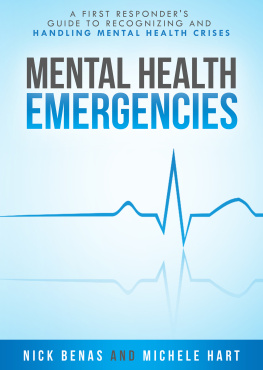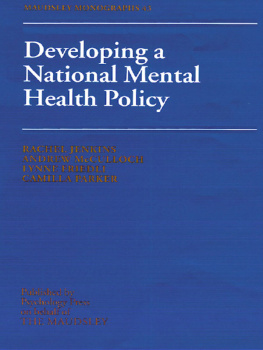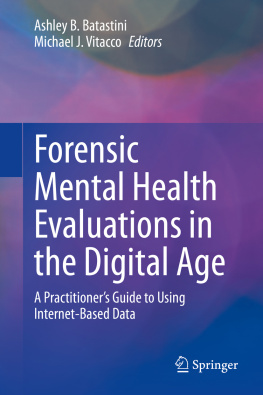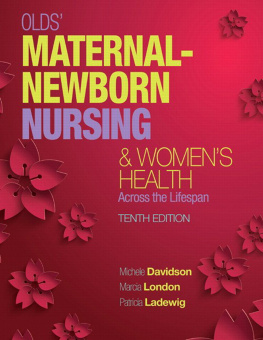
The way we handle mental health and mental illness in our society is neither fair nor effective. We have dumped so much of it onto the criminal justice system, which isnt any good for people who need treatment; it also puts police and correctional officers in impossible situations where they are bound to fail, sometimes tragically. Professor Bratina and the other contributors to this book do a fine job of dissecting the current situation and describing solutions that would greatly improve the terrible mess our negligence has created.
Gary Cordner,Professor Emeritus, Kutztown University
Forensic Mental Health
Forensic Mental Health: Framing Integrated Solutions describes a criminal justicemental health nexus that touches every populationjuvenile and adult male and female offenders, probationers and parolees, the aging adult prison population, and victims of crime. In the United States today, the criminal justice system functions as a mental health provider, but at great cost to society. The author summarizes the historical roots of this crisis and provides an overview of mental illness and symptoms, using graphics to illustrate the most prevalent disorders encountered by police and other first responders. Bratina demonstrates in detail how the Sequential Intercept Model (SIM) supports integration of the U.S. healthcare and justice systems to offer more positive outcomes for offenders with mental illness.
This book takes a multidisciplinary approach, addressing social work, psychology, counseling, and special education, and covers developments such as case law related to the right to treatment and trauma-informed care. Designed for advanced undergraduates, this text also serves as a training resource for practitioners working with the many affected justice-involved individuals with mental illness, including juveniles, veterans, and substance abusers.
Michele P. Bratina is an Assistant Professor in the Criminal Justice Department at West Chester University in West Chester, Pennsylvania. Previously, she was the Forensic and Childrens Mental Health Coordinator for the Florida Department of Children and Families in the 19th Judicial Circuita role that inspired this book. She is First Vice President of the Northeastern Association of Criminal Justice Sciences (NEACJS) Academy of Criminal Justice Sciences and holds the position of Executive Counselor for the Academy of Criminal Justice Sciences (ACJS) Juvenile Justice Section. Her research interests and publications revolve around issues related to human exploitation, criminological theory, race, social structure, ethnicity and crime, and forensic mental health. She has published her work in the Journal of Ethnicity in Criminal Justice and in the International Journal of Police Science and Management.
Forensic Mental Health
Framing Integrated Solutions
Michele P. Bratina
First published 2017
by Routledge
711 Third Avenue, New York, NY 10017
and by Routledge
2 Park Square, Milton Park, Abingdon, Oxon, OX14 4RN
Routledge is an imprint of the Taylor & Francis Group, an informa business
2017 Taylor & Francis
The right of Michele P. Bratina to be identified as author of this work has been asserted by her in accordance with sections 77 and 78 of the Copyright, Designs and Patents Act 1988.
All rights reserved. No part of this book may be reprinted or reproduced or utilized in any form or by any electronic, mechanical, or other means, now known or hereafter invented, including photocopying and recording, or in any information storage or retrieval system, without permission in writing from the publishers.
Trademark notice: Product or corporate names may be trademarks or registered trademarks, and are used only for identification and explanation without intent to infringe.
Library of Congress Cataloging-in-Publication Data
Names: Bratina, Michele P., 1972 author.
Title: Forensic mental health : framing integrated solutions / Michele P. Bratina.
Description: New York, NY : Routledge, 2017.
Identifiers: LCCN 2016054629 | ISBN 9781138935389 (hbk) | ISBN 9781138935396 (pbk) | ISBN 9781315677460 (ebk)
Subjects: LCSH: Forensic psychiatryMethods. | People with mental disabilities and crimeUnited States. | Mentally ill offendersCareUnited States.
Classification: LCC RA1151 .B73 2017 | DDC 614/.15dc23
LC record available at https://lccn.loc.gov/2016054629
ISBN: 978-1-138-93538-9 (hbk)
ISBN: 978-1-138-93539-6 (pbk)
ISBN: 978-1-315-67746-0 (ebk)
Typeset in Bembo
by Apex CoVantage, LLC
Visit the eResource: www.routledge.com/cw/9781138935396
For my dad, Vito William Bracciodieta.
Your encouragement and love will last forever.
The criminal justicemental health nexus is a profound topic in that it touches on every population in the field of criminal justicejuvenile and adult male and female offenders, probationers and parolees, sexually violent predators, the aging adult prison population, and victims of crime and serious abuse. Through a multifaceted approach to learning and understanding the crimemental health relationship, readers will be able to more effectively gauge the issues presented and the various ways in which they might become positive change agents in the field.
Prior to my career in academia, I had the fortunate experience of working for the Florida Department of Children and Families (DCF), Judicial Circuit 19, Substance Abuse and Mental Health Program Office (SAMH). I did not realize it at the time, but Dr. George Woodley, program administrator and all-around amazing human, had the keen ability to predict my future when he hired me in the summer of 2010. In the position of Forensic and Childrens Mental Health Coordinator, I was quickly forced to navigate multiple systems of care, as I was responsible for the direct oversight of contracted programs that provided an array of substance abuse and mental health services to children, adolescents, and adultsmany of whom were justice-involved. During that time, I witnessed a substantial amount of trauma and abuse and the resistance of service providers who were unable or unwilling to venture across systems to make change; however, I also observed glimpses of great healing and progress and the development of partnerships between people and agencies in places where I would least expect it.
Unfortunately, due to threats of restructuring and the elimination of many SAMH positions, including my own, I left SAMH to accept a tenure-track faculty position back in Pennsylvania. At about the same time, I accepted a temporary contracted position as a systems integrator. The meetings I facilitated involved individuals from multiple systems of care, including juvenile justice and criminal justice systems and child welfare, substance abuse, education, and several othersand we were engaging in information sharing beyond anything I had experienced before. So much of this text comes from that perspective. The original idea for the book, and the motivation necessary for its development and fruition, can be attributed to the traumatized children who suffer from want of true love and compassion; the stigmatized mental health court clients who proudly express their progress to an intimidating, yet relatable, judge; and the frustrations observed between educators, providers, and police who, from across a conference table, manage together to find solutions to the continued criminalization of mental illness.










